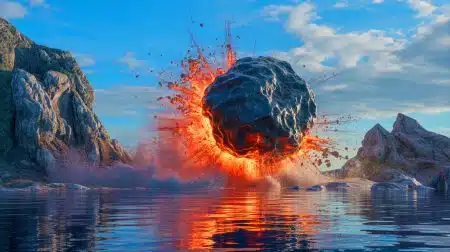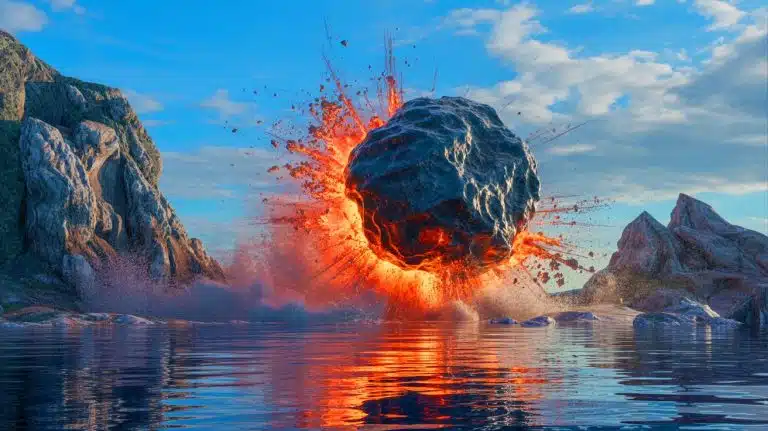| IN A NUTSHELL |
|
Hidden beneath 700 meters of sediment under the North Sea, the Silverpit crater has long been a subject of scientific intrigue. For more than two decades, researchers debated whether this circular depression was a result of an asteroid impact or merely a product of natural geological processes. Recent advancements in seismic imaging and rock analysis have finally provided clarity. A team of researchers has uncovered compelling evidence that the Silverpit crater, approximately three kilometers wide, was indeed formed by an asteroid impact around 43 to 46 million years ago. This finding not only closes a chapter of scientific debate but also offers insights into the history of asteroid impacts on Earth and potential future implications.
The Initial Discovery and Skepticism
In 2002, petroleum geoscientists mapping the seabed 80 miles off the coast of East Yorkshire first identified the Silverpit structure. Its perfect circularity, central peak, and surrounding faults initially suggested an impact crater. However, skepticism abounded. In 2009, the Geological Society of London conducted a debate where approximately 80 percent of scientists leaned towards a non-impact origin, attributing the formation to natural processes such as salt layer movement or sediment collapse. This prevailing skepticism overshadowed the impact theory for years, until new seismic data emerged.
In 2022, the Northern Endurance Partnership’s carbon storage exploration efforts provided new high-resolution seismic images of the seabed. These images offered much clearer views than previous surveys, reigniting interest in the impact hypothesis. The data revealed sharply defined faults and water-formed troughs consistent with an impact event, challenging prior assumptions. This pivotal moment marked a shift in understanding and set the stage for further investigation into the Silverpit crater’s origins.
Evidence Supporting the Asteroid Impact Theory
Using the 2022 seismic data, Uisdean Nicholson and his team detected distinctive features indicative of an impact event. Among these were secondary craters, rarely preserved on Earth, which added weight to the impact argument. However, the most compelling evidence came from rock samples. In 1985, British Gas had drilled a well near the crater, preserving sediments that would later prove invaluable. Analyzing these samples, researchers discovered quartz and feldspar crystals with microscopic deformation features—scars from an impact shockwave.
These atomic-scale deformations cannot be attributed to normal geological processes, providing irrefutable evidence of an impact origin. While only a single grain each of quartz and feldspar displayed these features, their presence was enough to confirm the hypothesis. This discovery, a result of meticulous analysis, underscored the significance of combining geological, seismic, and microscopic evidence in validating the impact theory.
Implications of the Silverpit Crater Discovery
With the confirmation of Silverpit as an impact crater, it joins a select group of known impact sites on Earth, comprising only about 200 on land and 33 beneath oceans. Its preservation offers a rare opportunity to study impacts in marine environments. The presence of secondary craters, in particular, provides insights into debris distribution during such events. This information is crucial for refining models of asteroid impacts in aquatic settings, which have been less understood compared to terrestrial impacts.
The Silverpit discovery also highlights the complexities of proving impact origins, especially with limited physical evidence. While some skeptics may question the findings, the comprehensive approach combining various scientific disciplines strengthens the impact explanation. Looking forward, the research team aims to use Silverpit as a model for understanding the dynamics of marine impacts, which could be vital for preparing for future asteroid threats.
Future Research and Broader Implications
The research surrounding the Silverpit crater is not just about understanding past events but also preparing for potential future scenarios. As researchers refine models of asteroid impacts, they contribute to global efforts in planetary defense. Understanding the impact dynamics in marine settings is particularly crucial, given Earth's vast ocean coverage. If a similar asteroid were to strike today, the consequences could be catastrophic, underscoring the importance of preparedness.
Beyond planetary defense, this discovery enriches our understanding of Earth's geological history. Each impact site offers a unique glimpse into past events that have shaped our planet's evolution. As scientists continue to explore these phenomena, the question remains: How can we leverage these insights to better protect our planet and anticipate future cosmic events?
The Silverpit crater's story is a testament to the power of persistence and technological advancement in unraveling Earth's geological mysteries. As scientists continue to investigate this and other impact sites, they not only deepen our understanding of the past but also prepare for the uncertainties of the future. What other secrets might the seabed hold, and how will they shape our understanding of Earth's dynamic history?
Did you like it? 4.5/5 (26)







Wow, this is like something out of a sci-fi movie! 🌌
Wow, 43 to 46 million years ago? That’s some serious deep time! 🌌